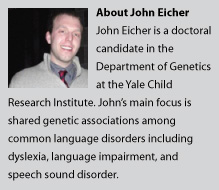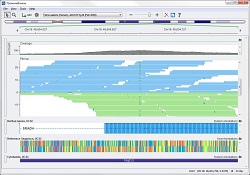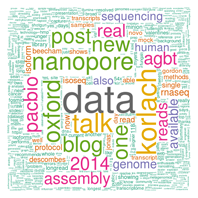The Differences Between EMMA and EMMAX
I recently gave a webcast on GWAS in a model organism: Arabidopsis thaliana; a question was brought up about the differences between EMMA and EMMAX and why the results with each would differ.
I recently gave a webcast on GWAS in a model organism: Arabidopsis thaliana; a question was brought up about the differences between EMMA and EMMAX and why the results with each would differ.
Join us tomorrow, July 9th at 12PM EDT, for Ashley Hintz’s webcast on GWAS in a Model Organism: Arabidopsis Thaliana. Joining the Golden Helix team as a Field Application Scientist in April of 2014, Hintz is the perfect candidate to present on Arabidopsis Thaliana given her background in zoology and phylogenetics of planigales.
It’s coming down to the wire – if you have not submitted your Golden Helix T-shirt design please do so!! We have already had many great submissions but we are missing yours. Once the contest closes tomorrow, July 3rd, our talented Golden Helix staff will narrow down the choices and display them to our community for voting. The designs with the… Read more »

Up until a few weeks ago, I thought variant classification was basically a solved problem. I mean, how hard can it be? We look at variants all the time and say things like, “Well that one is probably not too detrimental since it’s a 3 base insertion, but this frameshift is worth looking into.” What we fail to recognize is… Read more »
The 2014 MAGES Conference hosted in Philadelphia brought out the shining stars in Statistical Genetics, along with a variety of approaches and difficulties researchers in the field are facing. Being my first MAGES event, I did not know what to expect; however, I was thoroughly impressed and am excited to go back next year. Some of the topics that seemed… Read more »
We are incredibly excited to sponsor the 2014 Golden Helix Summer School (not directly affiliated with Golden Helix, Inc. (us)), hosted on the island of Aegina, Greece, from September 11th-15th, 2014. This year’s theme is “Pharmacogenomics and Genomic Medicine: Bridging research and the clinic” and will focus on disciplines within genomic medicine. The Golden Helix Summer School, conducted annually, is a… Read more »

Over the last few years, it’s clear that our t-shirts are loved. But the time has come for some fresh designs and we are looking to our customers and community for inspiration. Do you have a brilliant idea in mind for a Golden Helix t-shirt? Great! You should enter our first ever t-shirt contest! It’s pretty easy really; draw it… Read more »
We are excited to let you know about two new scripts to aid in Numeric Regression analysis. Don’t forget about the Technical Support Bulletins which keep you up-to-date on all the latest script news. You can stream this feed via an RSS reader, receive email updates, or see the latest on the SVS splash screen. Linear and Logistic Regression with… Read more »

When many people think of learning disabilities such as dyslexia and language impairment, they typically do not think of a biological or medical condition. Even more rarely do people think of these conditions as being the result of biological and genetic phenomena. However, that is exactly what I have thought of every day during my doctoral training in the Department… Read more »

For lead geneticist Dr. Matthew McClure, of the Irish Cattle Breeding Federation (ICBF), finding a software program that could handle massive amounts of data as well as more than the standard twenty-three pairs of chromosomes found in humans was a challenge. McClure says, “Agriculture often feels like the black sheep of the genomics industry. The majority of current genetic analysis… Read more »
Philadelphia. The City of Brotherly love, home of the Philadelphia cheesesteak, and home to the Children’s Hospital of Philadelphia, who took the No. 1 spot in this year’s U.S. News & World Report’s Best Children’s Hospitals Honor Roll. We are honored (and excited!) to sponsor this year’s Mid-Atlantic Epidemiology and Statistics (MAGES) Conference at the University of Pennsylvania. MAGES will… Read more »

The developers at Golden Helix have raised the bar again with the release of GenomeBrowe 2.0. About a year and a half after the initial release, Golden Helix has expanded the functionality of GenomeBrowse to fulfill feature requests from both fundamental research investigators and translational scientists who require a visualization tool to gain key insight into their results. The Golden… Read more »

Science is a collaborative endeavor. Rarely is it in isolation that new discovery takes place. Unfortunately, using a computer to perform analysis is almost always a solitary activity. Sharing what you have found with members of your team often means squeezing around a small 13” glowing rectangle. While looking at the same screen has its place, being able to save… Read more »
As I write this article, Golden Helix has hundreds of clients in top research institutions world-wide. The adoption of our product at these institutions ranges from a few individual users to site licenses used by entire organizations. Because of the quality of SNP & Variation Suite (SVS) and GenomeBrowse, our competence in the field is recognized, and increasingly our clients… Read more »

New breakthroughs are being made every day in genomics. It’s a dynamic and fascinating industry, and with exceptional growth forecast in the DNA sequencing market, a new generation of people are entering the field: future researchers, clinicians, counselors and doctors. This new generation will need to learn not only the science, but also understand how to process the massive amounts… Read more »
Today is a big day for us. Today we are announcing a major release of our flagship product, SNP & Variation Suite (SVS), to the general public. SVS 8 is a substantial improvement over the previous release in a number of dimensions (see detailed discussion on our What’s New page). We’ve come a long way. Over five years ago, in… Read more »
And the Winners Are… We recently held our first ever research competition at Golden Helix – what a success! We received over 50 submissions from more than 20 different countries. And just as the countries varied, so did the research. Abstracts involved both DNA and RNA sequencing, GWAS (nope, it’s still not dead), and copy number variation. Subjects ranged from… Read more »

On my flight back from this year’s Molecular Tri-Conference in San Francisco, I couldn’t help but ruminate over the intriguing talks, engaging round table discussions, and fabulous dinners with fellow speakers. And I kept returning to the topic of how we aggregate, share, and update data in the interest of understanding our genomes. Of course, there were many examples of… Read more »
Dr. Bryce Christensen recently gave a webcast on Maximizing Public Data Sources for Sequencing and GWAS Studies in which he covered options for getting GWAS and sequence information online, tips for working with these datasets and what you’ll see in terms of data quality and usefulness, how to use public data sources in conjunction with your GWAS or sequence study… Read more »
Weather.com currently says it feels like -24 degrees outside (yes, that’s negative) here in Bozeman, Montana. Which is why I’m more than a little jealous of Gabe Rudy and Andreas Scherer who get to go to San Francisco and Marco Island next week, respectively, where the weather is little more… well, let’s say… reasonable. Andreas will be headed to Marco… Read more »